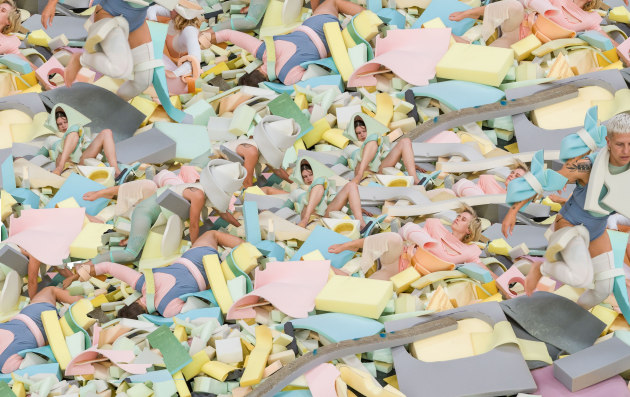REVIEWS: TASDANCE at MONA FOMA
BODY BODY COMMODITY
Earl Arts Centre, Launceston
Reviewed February 18
Presented by Tasdance and MONA FOMA
BABY GIRL
The Nolan Gallery
MONA (Museum of Old and New Art)
nipaluna/Hobart
Reviewed Feb 25
Presented by Tasdance and MONA FOMA

The Earl Arts Centre stage isn’t large, but for Body Body Commodity designer Michelle Boyde has covered it in a mass of various sized and shaped foam offcuts. Upstage sound designer, Anna Whitaker, plays slow notes on a violin which feeds the gentle sounds emanating from her audio workbench. All is pastel and calm, at least for a while.
Concealed figures, strongly reminiscent of Picasso’s Cubist costumes in Parade (1917), sprout from the floor. The disguised forms of their bodies are covered by the same mix of pastel foam shapes, but they are shaking disconcertingly and begin shovelling the mass of pastel pieces aside with their open legs.
The women now have more space and fewer restrictions to their movement. In turn, choreographer Jenni Large and dance collaborators – Amber McCartney, Ashleigh Musk, Erin O’Rourke and Georgia Rudd – caress and posture with single panels of foam in a gameshow-like display of desirable goods. There is an increasingly competitive air in the way the objects are presented and discarded in a desperation to please. Countering any sense of exertion and very conscious of the audience’s gaze, each dancer repeats gentle powder puff moves over their body, while McCartney takes centre stage cradling an anthropomorphised chunk of foam with gushing grief.
TV soap-style exaggeration makes way for more defiant actions, uncomfortably breaking into the audience’s space. The mood has changed, and the layers of the costumes stripped down. Each performer’s body is on display, not naked but visible in tight pastel, joining a procession of vignettes of "hunted", "led" and "possessed" bodies travelling across the stage. As the images melt out of focus the chaotic live soundscape is built by looping each performer’s vocal contribution. Guttural screams and exhausted breathing accompany a series of furious vocalisations as the movement builds into a unison ensemble rejecting the commodification of female bodies: "Don’t touch me, don’t fuck me, don’t lie to me and don’t judge me"; "Don’t tell me what to do; Don’t put me on display; You don’t own me". Some threats are applied.
Large is not disguising her message and the audience is witnessing a deep-seated frustration with the way female bodies are so often viewed and portrayed. Skilful and at times beautifully understated, the performances from each member of this very strong ensemble build the palpable anger in this work.

AT THE NOLAN Gallery in Hobart, Amber Macartney's Baby Girl, a solo work, is breathtakingly engaging. Billed as "A dance performance of a figure caught between their original memories and the persona of a new, otherworldly being", it appears as a narrative, but could be interpreted in other ways.
Baby Girl is set in the dominant presence of the huge Sidney Nolan (1971-72) artwork Snake, Chris Jackson’s lighting allowing both dancer and artwork to coexist.
Running in from off stage, choreographer/performer McCartney literally throws her body into the space, landing with a clatter. Her grotesquely masked head is challenging to look at. Embryonic, distorted proportions have also taken over where her hands would be. The relationship between her body parts is reconfigured several times as she quivers and struggles, squashed in a confined space of her own making. In the corner of this huge open space she is fighting with her own body: exploring possibilities which generally don’t match human capabilities. Eventually she slithers across the floor, expanding into worm-like forms in an internal struggle with her own shape and identity. With sudden shifts and wobbles, she is totally in control of her extraordinary body. Her limbs appear to be able to be able to go anywhere and folds of skin are no barrier to exploration.
Momentarily upright, the range of McCartney’s movement vocabulary is mesmerising. Smooth undulation easily shifts to isolated quaking and rippling tension. Her extremely articulate body reflects so many images that the audience cannot take their eyes from her travails. Detailed and whole-body muscle effort builds momentum with incremental levels of control.
To describe what occurs next would be a spoiler, but it is fair to say that there is a highly inventive transformation employing simple objects. McCartney holds the audience in the palm of her hand and continues to claim the space well after her departure. This is memorable work from a performer at the top of her game.
– LESLEY GRAHAM
Stay up to date with news and reviews! Subscribe to our e-news: just go to our homepage and click the Newsletter Signup box. It's free!


